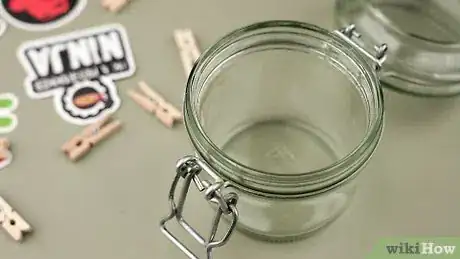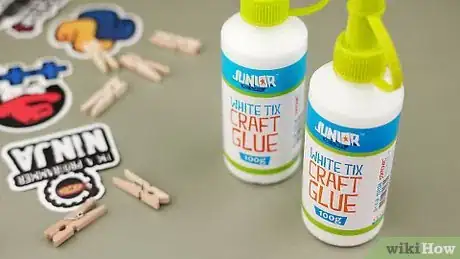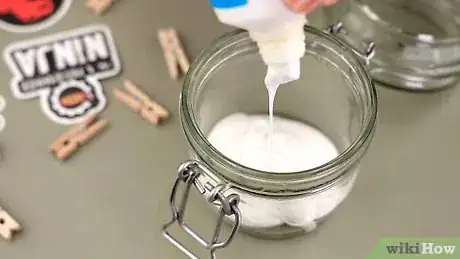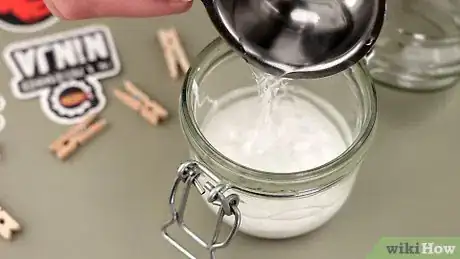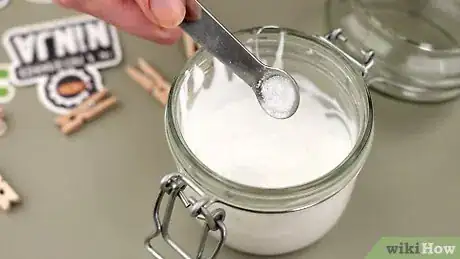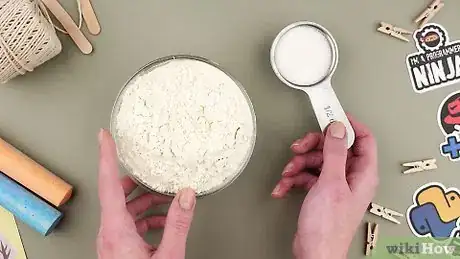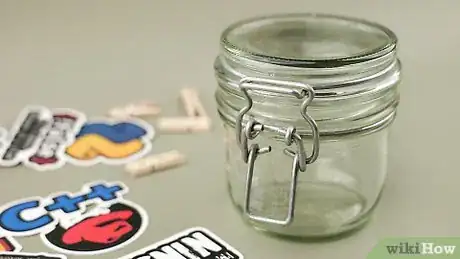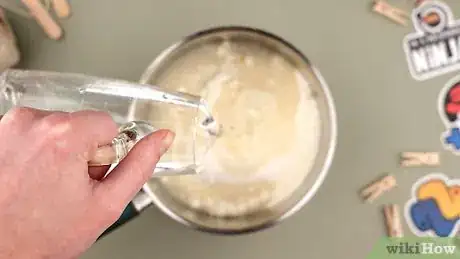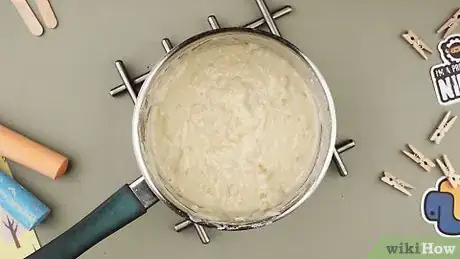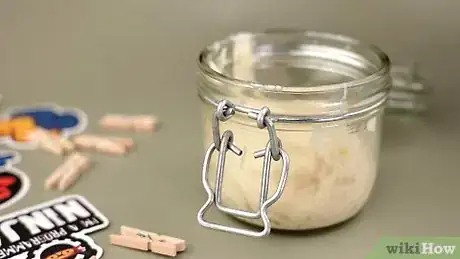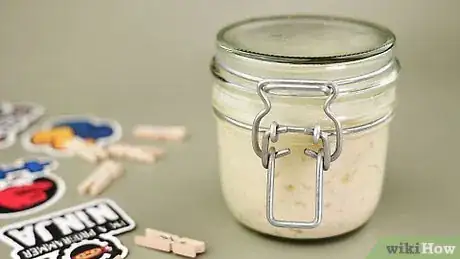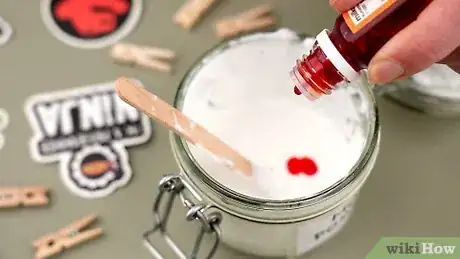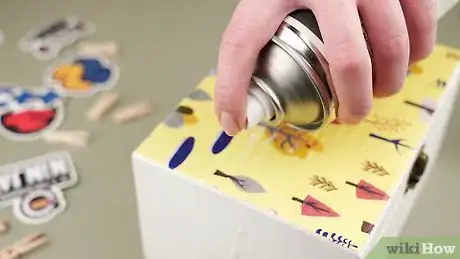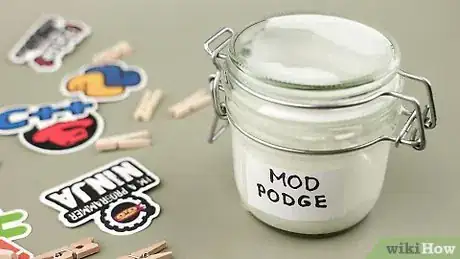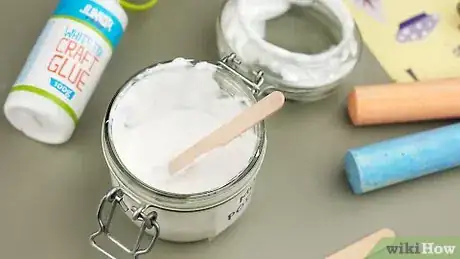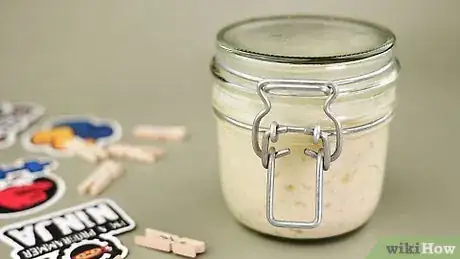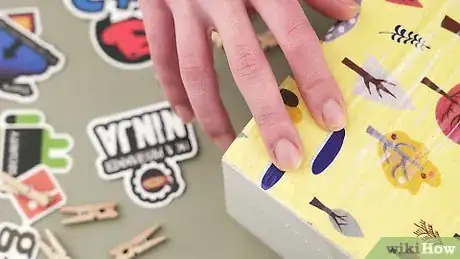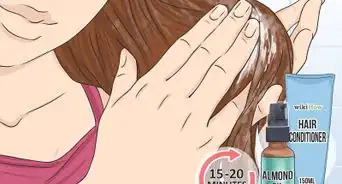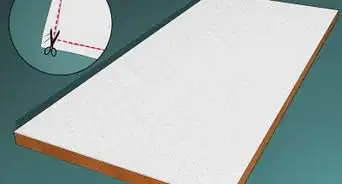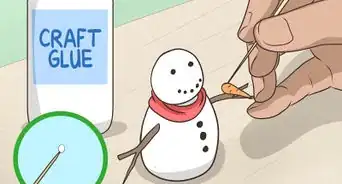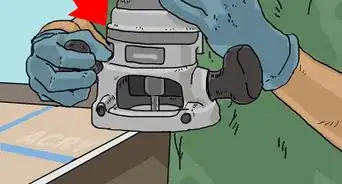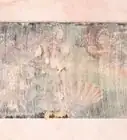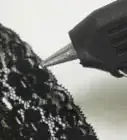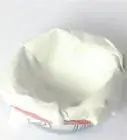This article was co-authored by Nicole Bolin. Nicole Bolin is a Crafting Specialist and the CEO of Stencil, a DIY Craft Studio in Phoenix, Arizona. Nicole specializes in interior design and various craft and DIY projects. Nicole holds a Certificate in Interior Design from the New York Institute of Art and Design. She opened Stencil in 2017 to teach others to create DIY projects that fit their home and lifestyle.
wikiHow marks an article as reader-approved once it receives enough positive feedback. This article received 25 testimonials and 90% of readers who voted found it helpful, earning it our reader-approved status.
This article has been viewed 1,071,900 times.
Mod Podge is a brand of craft glue most commonly used to seal and finish decoupage art. The store brand version can get a bit pricey, but you can make a bargain bin variant at home using common materials like school glue and flour.
Ingredients
- 1 ½ cups (210 grams) flour
- ¼ cup (56.25 grams) granulated sugar
- 1 cup (225 milliliters) cold water
- ¼ teaspoon olive oil (optional)
- ¼ teaspoon vinegar (optional)
- 8 ounces (225 milliliters) white craft glue
- 4 ounces (112.50 milliliters) water
- 2 tablespoons of water-based varnish (optional)
- 2 tablespoons super-fine glitter (optional)
Steps
Making Glue-Based Mod Podge
-
1Wash out a jar with a tight-fitting lid. You will need a clean jar with a tight-fitting lid that can hold 12 ounces (355 milliliters). The jar can be made out of glass or plastic.
- If you plan on making glossy or glittery Mod Podge, you will need a slightly-larger jar.
-
2Find some craft glue. You will need about 8 ounces (225 milliliters) of white, liquid glue—the sort kids use in school. If your bottle already contains 8 ounces/225 milliliters (or close to it) then you will not need to measure it out. If your bottle contains more glue, however, then you will need to pour the glue into a measuring cup to make sure that you have the right amount.
- Consider using an acid-free scrapbooking glue. It is more durable and less-likely to yellow than regular glue.
- Elmer's glue will work just fine.[1]
Advertisement -
3Open the bottle of glue, and pour it into the container. You can simply rest the glue bottle over the rim of the jar and let the glue drain on its own, or you can squeeze it out. If the glue is thick and will not come out easily, you can pour a little bit of hot, boiling water into the glue bottle, close the cap tightly, and shake. The hot water will help loosen the glue. Open the glue bottle again and pour it into the jar—it should come out easier now.
- Consider warming the glue in a microwave for about 30 seconds (or fewer, depending on the strength of your microwave). This will help the glue bottle empty easier and faster.
-
4Add the water into the container. Once the glue has completely drained, pour 4 ounces (112.50 milliliters) of water into the jar and stir to combine it.[2]
-
5Add gloss or varnish to make it shiny. Your Mod Podge will be matte by default, but you can make it shiny by adding 2 tablespoons of a water-based gloss or varnish. Simply add the gloss or varnish after you have added the water.[3]
-
6Consider making sparkly Mod Podge. If you wish to make glittery Mod Podge, add 2 tablespoons of glitter into the mixture. This is most effective when combined with the water-based varnish or gloss.[4]
-
7Close the lid tightly and shake it. Once you have added everything into the jar, close the lid tightly and shake it to mix everything together. If any of the Mod Podge seeps out from under the lid, simply clean it off with a damp cloth. Mod Podge won't yellow over time whereas Elmer's Glue will, so be aware of that.[5]
Making Flour-Based Mod Podge
-
1Consider the requirements of your project. Because the Mod Podge you will be making in this section uses flour and sugar, the finished texture may be a little grainy. Keep this in mind when using this version as a sealer.
-
2Find a clean jar with a tight-fitting lid. You will need a clean jar with a tight-fitting lid. It should be able to hold 12 ounces (355 milliliters). The jar can be made out of glass or plastic.
-
3Combine flour and sugar in a pot. Sift 1 ½ cups (210 grams) of flour and ¼ cup (56.25 grams) of granulated sugar into a pot. Do not place the pot on the store, and do not turn the stove on just yet.
-
4Add the water and stir. Pour 1 cup (225 milliliters) of cold water into the pot and beat rapidly with a whisk to mix everything together and get rid of any clumps.
- Consider adding ¼ teaspoon of oil. This will help make the product glossier in the end.
-
5Turn on the stove and stir the ingredients. Use medium heat and do not let the contents of the pot boil. You want to end up with a thick, glue-like consistency. If the mixture starts to become too thick, then add more water and keep stirring.
- Consider adding vinegar. Adding ¼ teaspoon of vinegar can help control fungus and mold from developing in your Mod Podge. If you choose to add vinegar, do so after you have removed the pot from the stove, and give the Mod Podge one, final stir.
-
6Remove the pot from the stove and let it cool. Once the mixture has thickened, turn the stove off, and set the pot down onto a heat-resistant surface. Let the mixture cool completely before proceeding to the next steps, or else the Mod Podge may begin to ferment.
-
7Transfer everything the mixture into a jar. Hold the pot over your jar and carefully tip the contents into the jar. You can use a spoon or spatula to help guide the mixture. If necessary, you may give the mixture a stir once everything is in the jar.
-
8Close the lid and store the Mod Podge in a cool place. Once again, make sure that your Mod Podge is completely cool before you place the lid on. Because you have made your Mod Podge out of natural ingredients, you will need to store it in a cool place, such as a refrigerator. Use it within a week or two. If it starts to rot and mold, discard it.
Using Your Mod Podge
-
1Consider adding a label the jar. You can design and print a label using adhesive paper, or you can make a label from scratch using a piece of paper and clear tape. Make the label after you have poured the Mod Podge into the container and shaken it up. Here is how you can make a label from scratch, without a computer or printer:
- Write "Mod Podge" or "Decoupage" on a small piece of paper.
- Cut a piece of clear, packaging tape that is bigger than your label.
- Place the label face down onto the middle of the piece of tape.
- Wrap the packing tape around the glass container. Smooth the tape down to rid the label of any air bubbles.
-
2Use Mod Podge to decorate boxes and other items. Simply apply a thin layer of Mod Podge to the area you want decorated using a paint brush. You can also use a foam brush as well. Press your fabric or paper onto the wet Mod Podge, making sure to smooth out any ripples, bubbles or creases. Apply a second, thin layer of Mod Podge on top of your fabric or paper. You can always apply another coat of Mod Podge after the first one has dried.[6]
-
3Consider tinting your Mod Podge. If you made Mod Podge out of glue and water, you can add a few drops of food coloring, and then paint it over some mason jars. This will create colored mason jars. Be sure to add 2 tablespoons of water-based gloss or varnish to your Mod Podge, or else the jars will be matte and frosted-looking.
- If you wish to create tinted mason jars that look like sea glass, then omit the varnish.
-
4Consider sealing your project. Your homemade Mod Podge will not be as durable as the store-bought variety. You can make it more durable by wait until it has dried completely (several hours) and then applying spray-on acrylic sealer.
- Simply hold the can six to eight inches away from the surface and spray the paint on using light, even strokes. Once the sealer has dried, you may add a second coat, if necessary.
- If you added varnish or glitter to your Mod Podge to make it glossy, be sure that you use an acrylic sealer with a gloss finish.
Consider the Benefits and Drawbacks
-
1Know that homemade Mod Podge is not the same as store-bought Mod Podge. When making and using these recipes, keep in mind that homemade Mod Podge is not the same as store-bought Mod Podge. There are several differences between the two, and this section will address them.
-
2Keep in mind that homemade Mod Podge costs less than Store-bought Mod Podge. Store-bought Mod Podge can be very expensive, so it is no surprise that many crafters attempt to make their own recipes out of materials many of them already have at home.
-
3Understand that the quality between the two is different. Homemade Mod Podge is usually made using watered-down glue, so it lacks some of the properties that store-bought Mod Podge has. Store-bought Mod Podge can be used as both an adhesive and sealant, making it durable. The homemade version is less-adhesive, and lacks varnish or sealer.=
- To make your homemade Mod Podge more durable, consider spraying your project with an acrylic sealant after the Mod Podge has dried.#Know that the finish differs between the two. Store-bought Mod Podge comes in all sorts of finishes from glossy, to satin, to matte. It even comes in glow-in-the-dark and sparkling varieties. Unless you add varnish or glitter, your homemade Mod Podge will be matte.
- Flour-based Mod Podge will may leave behind some residue or a grainy texture.
-
4Understand that flour-based Mod Podge is perishable. It is possible to make Mod Podge out of completely edible and non-toxic materials, such as flour. Unfortunately, this also makes the final product perishable. You must store it in a cool place and use it within a week or two, or else it will expire and begin to rot.
Expert Q&A
Did you know you can get premium answers for this article?
Unlock premium answers by supporting wikiHow
-
QuestionCan you use Elmer's glue instead of Mod Podge?
 Nicole BolinNicole Bolin is a Crafting Specialist and the CEO of Stencil, a DIY Craft Studio in Phoenix, Arizona. Nicole specializes in interior design and various craft and DIY projects. Nicole holds a Certificate in Interior Design from the New York Institute of Art and Design. She opened Stencil in 2017 to teach others to create DIY projects that fit their home and lifestyle.
Nicole BolinNicole Bolin is a Crafting Specialist and the CEO of Stencil, a DIY Craft Studio in Phoenix, Arizona. Nicole specializes in interior design and various craft and DIY projects. Nicole holds a Certificate in Interior Design from the New York Institute of Art and Design. She opened Stencil in 2017 to teach others to create DIY projects that fit their home and lifestyle.
Crafts & DIY Specialist Yes, Elmer's glue thinned out with a little bit of water can work as Mod Podge. However, Elmer's glue will yellow over time. If you're using it for something you're going to get rid of afterwards like a Halloween decoration, that's fine. However, if you're using it for something important you want to keep for a while, you might want to stick with normal Mod Podge.
Yes, Elmer's glue thinned out with a little bit of water can work as Mod Podge. However, Elmer's glue will yellow over time. If you're using it for something you're going to get rid of afterwards like a Halloween decoration, that's fine. However, if you're using it for something important you want to keep for a while, you might want to stick with normal Mod Podge. -
QuestionWhat is Mod Podge?
 wikiHow Staff EditorThis answer was written by one of our trained team of researchers who validated it for accuracy and comprehensiveness.
wikiHow Staff EditorThis answer was written by one of our trained team of researchers who validated it for accuracy and comprehensiveness.
Staff Answer wikiHow Staff EditorStaff AnswerMod Podge is a mixture of glue and sealer, and a finish; this combination of ingredients allows you to stick items and once the Mod Podge has dried, the object will be sealed and finished already (either glossy or matte, depending on which Mod Podge is used). Mod Podge is suitable for a range of craft products including decoupage, paper craft and papier maché. It works on paper, wood, fabric and some natural items such as leaves. The glue dries clear, the sealer protects the item, while the finish can even be sanded to be as smooth as you’d like (depending on what the material covered is).
wikiHow Staff EditorStaff AnswerMod Podge is a mixture of glue and sealer, and a finish; this combination of ingredients allows you to stick items and once the Mod Podge has dried, the object will be sealed and finished already (either glossy or matte, depending on which Mod Podge is used). Mod Podge is suitable for a range of craft products including decoupage, paper craft and papier maché. It works on paper, wood, fabric and some natural items such as leaves. The glue dries clear, the sealer protects the item, while the finish can even be sanded to be as smooth as you’d like (depending on what the material covered is). -
QuestionHow do I store my excess Mod Podge?
 wikiHow Staff EditorThis answer was written by one of our trained team of researchers who validated it for accuracy and comprehensiveness.
wikiHow Staff EditorThis answer was written by one of our trained team of researchers who validated it for accuracy and comprehensiveness.
Staff Answer wikiHow Staff EditorStaff AnswerExcess homemade Mod Podge should be kept in a jar with the lid screwed on tightly. Store in a cool and dry place. If you’ve used organic ingredients, such as flour, it needs to be refrigerated and used within 2 weeks, otherwise it will go bad. For commercial Mod Podge, keep the lid shut and store in a cool, dry place. It should last for a few years if stored properly.
wikiHow Staff EditorStaff AnswerExcess homemade Mod Podge should be kept in a jar with the lid screwed on tightly. Store in a cool and dry place. If you’ve used organic ingredients, such as flour, it needs to be refrigerated and used within 2 weeks, otherwise it will go bad. For commercial Mod Podge, keep the lid shut and store in a cool, dry place. It should last for a few years if stored properly.
Things You'll Need
- Glass jar or container, with lid
- Sauce pan or pot (version two)
- Spoon or whisk (version two)
- Measuring cup
References
- ↑ Nicole Bolin. Crafts & DIY Specialist. Expert Interview. 29 October 2020.
- ↑ Nicole Bolin. Crafts & DIY Specialist. Expert Interview. 29 October 2020.
- ↑ https://paintedfurnitureideas.com/homemade-mod-podge-recipes/
- ↑ https://paintedfurnitureideas.com/homemade-mod-podge-recipes/
- ↑ Nicole Bolin. Crafts & DIY Specialist. Expert Interview. 29 October 2020.
- ↑ https://www.youtube.com/watch?v=16yKRerI-YI
About This Article
To make glue-based Mod Podge, start by pouring white school glue into a clean jar. Then, add 1 fluid ounce of water to the container for every 2 fluid ounces of glue. If you’d like, you can add varnish to the solution to make it shiny or glitter to make it sparkly. Once you’ve added all the ingredients, cover the container with a lid and shake it thoroughly to mix everything together. To learn how to make flour-based Mod Podge, scroll down!
